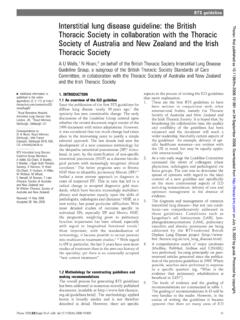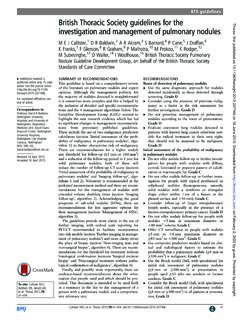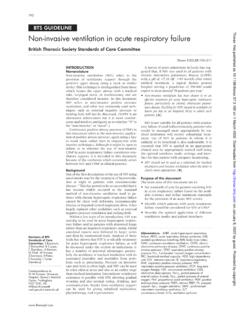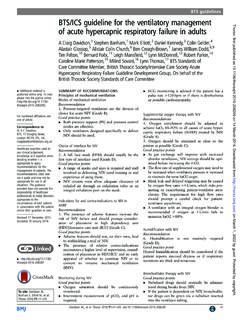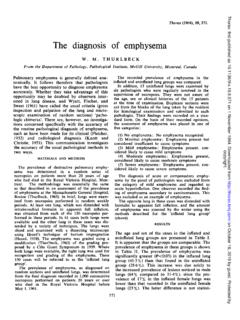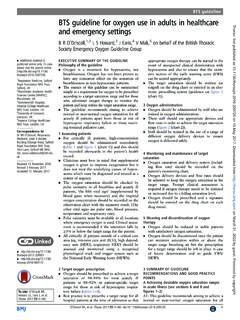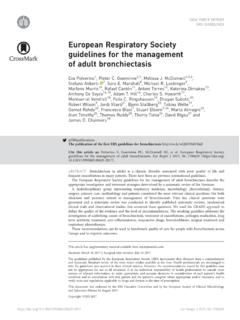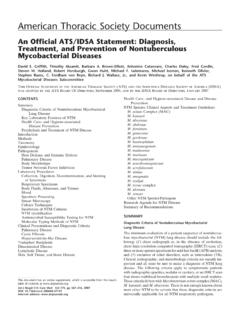Transcription of British Thoracic Society Guideline for bronchiectasis in ...
1 British Thoracic Society Guideline for bronchiectasis in adultsAdam T Hill,1 Anita L Sullivan,2 James D Chalmers,3 Anthony De Soyza,4 J Stuart Elborn,5 R Andres Floto,6,7 Lizzie Grillo,8 Kevin Gruffydd-Jones,9 Alex Harvey,10 Charles S Haworth,7 Edwin Hiscocks,11 John R Hurst,12 Christopher Johnson,7 W Peter Kelleher,13,14,15 Pallavi Bedi,16 Karen Payne,17 Hashem Saleh,8 Nicholas J Screaton,18 Maeve Smith,19 Michael Tunney,20 Deborah Whitters,21 Robert Wilson,14 Michael R Loebinger14 BTS GuidelineTo cite: Hill AT, Sullivan AL, Chalmers JD, et al. Thorax 2019;74 (Suppl 1):1 numbered affiliations see end of toProfessor Adam T Hill, Respiratory Medicine, Royal Infirmary of Edinburgh, Edinburgh and University of Edinburgh, EH16 4SA, UK; adam. hill318@ nhs. net http:// dx. doi. org/ thoraxjnl- 2018- 212468 Author(s) (or their employer(s)) 2018.
2 No commercial re-use. See rights and permissions. Published by of reCommendaTionS and Good praCTiCe poinTSHow should the diagnosis of bronchiectasis be determined?Recommendations Imaging Perform baseline chest X-ray in patients with suspected bronchiectasis . (D) Perform a thin section computed tomography scan (CT) to confirm a diagnosis of bronchiec-tasis when clinically suspected. (C) Perform baseline imaging during clinically stable disease as this is optimal for diagnostic and serial comparison purposes. (D)Good practice pointsCT imaging protocol The most appropriate imaging protocol will vary according to scanner technology and patient factors. When using volumetric CT, dose reduction techniques including adaptive mA and kV and iterative reconstruction should be utilised where available.
3 Typical CT imaging parameters for the diag-nosis of bronchiectasis are: Slice thickness: 1mm Reconstruction algorithm: high spatial frequency kVp: 100-140 mAs (or effective mAs): 100 200 Gantry rotation time: < features of bronchiectasis bronchiectasis is defined by bronchial dilatation as suggested by one or more of the following: Bronchoarterial ratio >1 (internal airway lumen vs adjacent pulmonary artery) Lack of tapering Airway visibility within 1cm of costal pleural surface or touching mediastinal pleura. The following indirect signs are commonly associated with bronchiectasis : Bronchial wall thickening Mucus impaction Mosaic perfusion / air trapping on expir-atory CTGeneral CT scanning can also aid in identifying an aeti-ology of bronchiectasis eg Allergic bronchopul-monary aspergillosis (ABPA), Non-tuberculous mycobacteria (NTM), primary ciliary dyski-nesia, alpha one antitrypsin deficiency, Williams Campbell syndrome and a foreign whom should the diagnosis of bronchiectasis be suspected?
4 Recommendations Consider investigation for bronchiectasis in patients with persistent production of mucop-urulent or purulent sputum particularly with relevant associated risk factors. (D) Consider investigation for bronchiectasis in patients with rheumatoid arthritis if they have symptoms of chronic productive cough or recurrent chest infections. (C) Consider investigation for bronchiectasis in patients with Chronic Obstructive Pulmonary Disease (COPD) with frequent exacerbations (two or more annually) and a previous positive sputum culture for P. aeruginosa whilst stable. (B) Consider investigation for bronchiectasis in patients with inflammatory bowel disease and chronic productive cough. (C)Good practice points In at risk groups, if bronchiectasis is suspected, bronchiectasis needs confirmation.
5 In patients with COPD, investigation for bron-chiectasis may be appropriate especially in the presence of chronic productive cough with posi-tive sputum cultures for potentially pathogenic microorganisms (PPM) whilst stable or 2 or more exacerbations in the preceding 12 months. In patients with asthma, investigation for bron-chiectasis may be appropriate with severe or poorly-controlled disease. In patients with a history of HIV-1 infection, solid organ and bone marrow transplant, and history of immunosuppressive therapy for lymphoma and vasculitis, investigation for bronchiectasis may be appropriate with symp-toms of chronic productive cough or recurrent chest infections. 1 Hill AT, et al. Thorax 2019;74(Suppl 1):1 69. on February 4, 2022 by guest. Protected by : first published as on 13 December 2018.
6 Downloaded from BTS Guideline In patients with chronic rhinosinusitis, investigation for bronchiectasis may be appropriate with symptoms of chronic productive cough or recurrent chest infections. In patients with other connective tissue disease or inflamma-tory bowel disease, investigation for bronchiectasis may be appropriate if they have symptoms such as chronic produc-tive cough or recurrent chest infections. Investigation for bronchiectasis may be appropriate in other-wise healthy individuals with a cough that persists for longer than 8 weeks, especially with sputum production or a history of an appropriate trigger (see BTS Recommendations for the management of cough in adults (61)).investigations for causes of bronchiectasisRecommendations (see Table 1) A panel of investigations should be performed to establish the underlying cause of bronchiectasis .
7 (B)a. Co-morbidities and past medical history should be recorded in patients diagnosed with bronchiectasis to identify relevant and possibly causative disease such as rheumatoid arthritis, COPD, asthma, gastro-oesophageal reflux disease and inflammatory bowel disease. (C)b. Measure full blood count, serum total IgE and assess-ment of sensitisation (specific IgE or skin prick test) to Aspergillus fumigatus in all patients with bronchiectasis . (D)c. Serum Immunoglobulin G (IgG), Immunoglobulin A (IgA) and Immunoglobulin M (IgM) should be performed in all patients with bronchiectasis . (C)d. Consider measuring baseline specific antibody levels against capsular polysaccharides of Streptococcus pneu-moniae in all patients to investigate for specific antibody deficiency. If pneumococcal antibodies are low, immunise with 23 valent polysaccharide pneumococcal vaccine, followed by measurement of specific antibody levels 4 8 weeks later.
8 (D)e. Test for cystic fibrosis (according to NICE guidelines for Cystic Fibrosis (CF)) in patients with supporting clinical features, for example, early onset, male infertility, malab-sorption, pancreatitis. (B)f. Test for Primary Ciliary Dyskinesia (PCD) (according to ERS guidelines for PCD Diagnosis) in patients with supporting clinical features, including a history of neonatal distress, symptoms from childhood, recurrent otitis media, rhinosinusitis, or infertility. (A)g. Sputum cultures should be performed in all patients with bronchiectasis for routine and mycobacterial culture. (D)Good practice points A previous diagnosis of idiopathic bronchiectasis should prompt careful reinvestigation for a primary cause in the context of a deteriorating clinical course or a young patient (usually considered to be age 50 and under but not limited to this age group).
9 Referral to a specialist centre for investigation should be considered for young patients (usually considered to be age 50 and under but not limited to this age group) and those with apparent idiopathic bronchiectasis especially where there is evidence of progressive disease. Consider testing for rheumatoid factor (RF), anti-cyclic citrullinated peptide (anti CCP), antinuclear antibodies (ANA) and anti-neutrophil cytoplasmic antibodies (ANCA) in patients with coexisting clinical features of arthritis, connective tissue disease and/or systemic vasculitis. Consider testing for alpha 1 antitrypsin (A1AT) deficiency in patients with coexisting basal panacinar emphysema. Investigations for reflux and aspiration should be under-taken only in symptomatic patients, or where there are other suggestive clinical features.
10 Consider bronchoscopy for patients with localised disease to rule out an endobronchial lesion or foreign body as the cause of bronchiectasis . A bronchial aspiration or bronchial wash targeting the areas of bronchiectasis from CT scan of the chest should be consid-ered in patients who do not expectorate and can be particu-larly helpful in the diagnosis of NTM pulmonary disease. Serum protein electrophoresis should be performed in all patients with bronchiectasis with raised immunoglobulins. Consider HIV-1 serology in patient with bronchiectasis depending on prevalence of HIV-1 and clinical features suggestive of increased risk of retroviral recommendationsConsensus criteria for diagnosis of ABPA need to be validated in bronchiectasis criteria for definition of abnormal post pneumococcal test immunisation antibody responses need to be validated in bronchiectasis scoringGood practice point Consider using the bronchiectasis severity index which may help guide state treatmentWhich patients should be taught airway clearance techniques?

